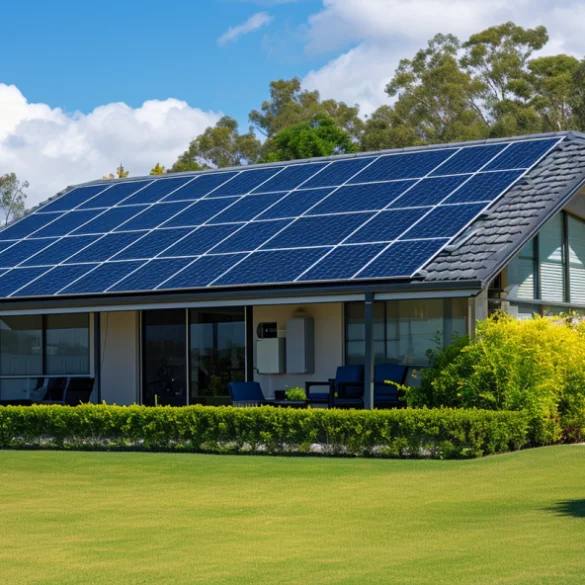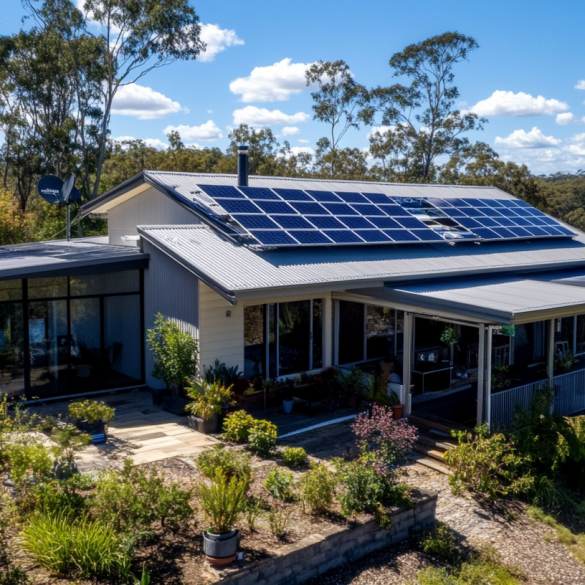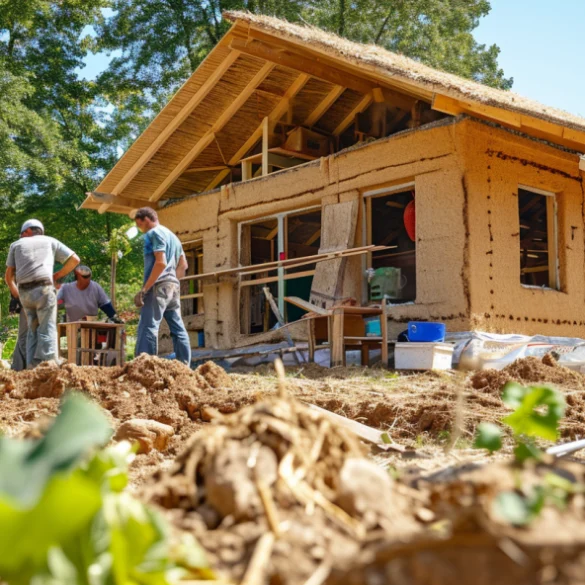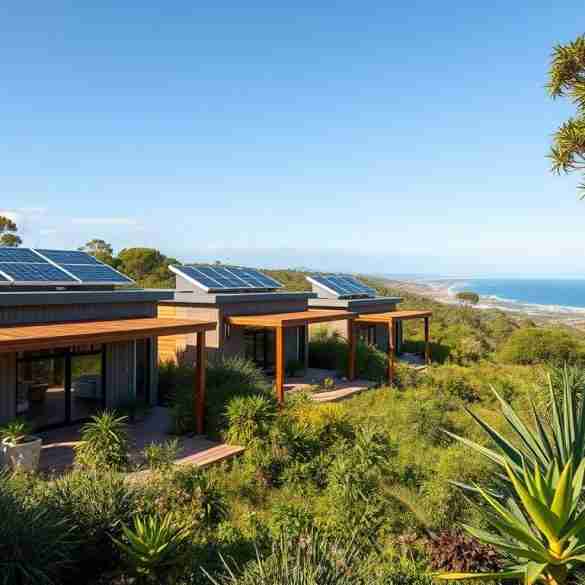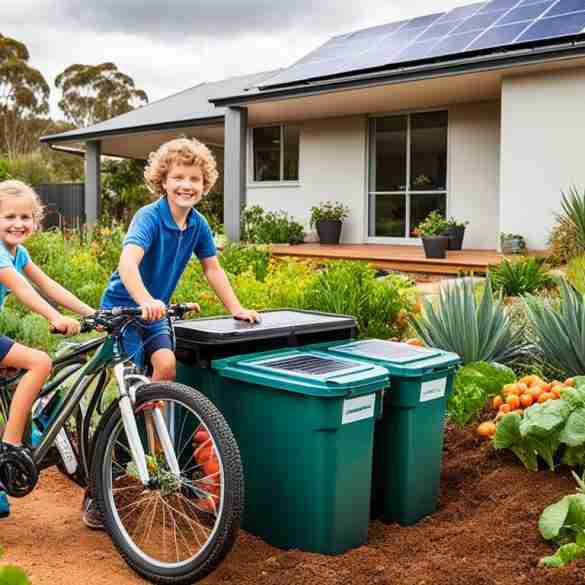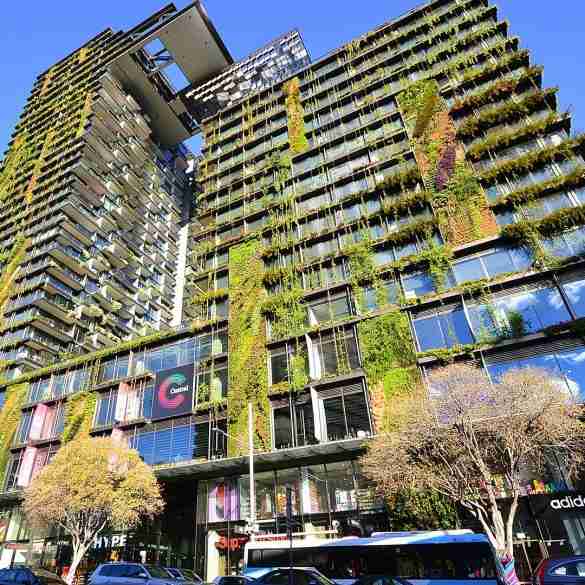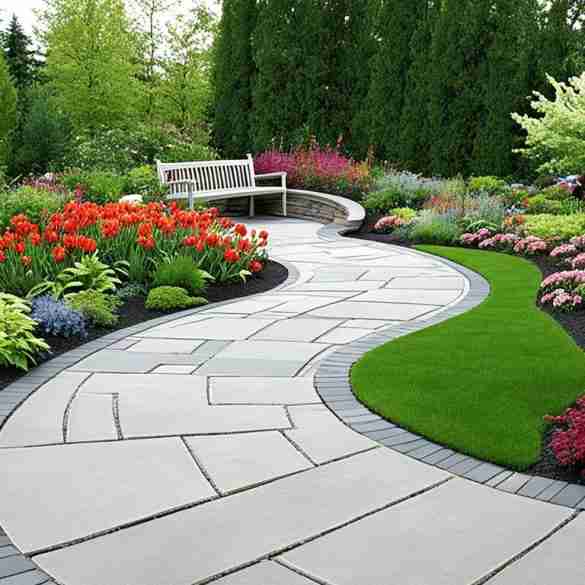Welcome to Sustainable Home Magazine, where we bring you practical tips and ideas to live a more eco-friendly and sustainable lifestyle. In this article, we will dive into the world of home composting and provide you with all the essential information and tips you need to get started. Whether you have a small apartment or a spacious backyard, composting at home is a simple and effective way to reduce waste, enrich your soil, and contribute to a greener planet.
Composting is not only good for the environment, but it also benefits your garden. By composting your food scraps, yard waste, and other organic materials, you can create nutrient-rich compost that improves soil health and promotes plant growth. With a few easy steps, you can turn your kitchen and garden waste into a valuable resource.
If you’re new to composting, don’t worry! We will guide you through different composting methods, including joining a city-wide composting program, composting outside in your yard, or micro-composting inside your home. We’ll also cover choosing the right compost bin, filling it with the right materials, and what items you can and cannot compost. By the end of this article, you’ll be equipped with the knowledge and inspiration to start your composting journey.
So, let’s dive in and discover the world of home composting and the numerous benefits it offers. Whether you’re interested in DIY composting, composting methods, or home composting tips, we’ve got you covered!
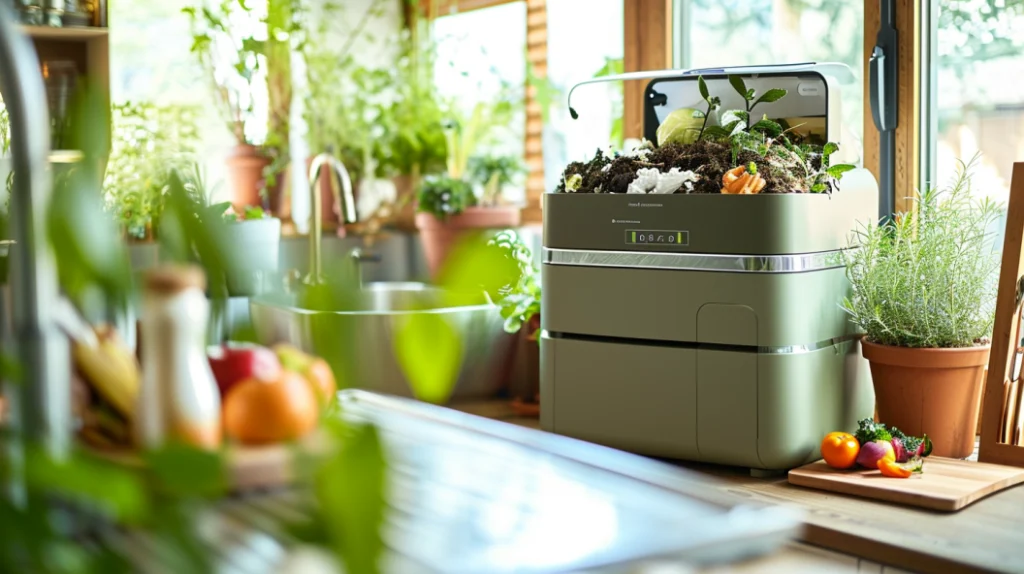
Key Takeaways for Composting at Home
- Composting at home is an easy and effective way to reduce waste and improve your garden.
- There are several options for home composting, including city-wide composting programs, composting outside in your yard, or micro-composting inside your home.
- Choosing the right compost bin and filling it with a mix of green and brown materials is crucial for successful composting.
- There are certain items you can compost, such as fruit and vegetable scraps, paper towel rolls, and coffee grounds, and items you should avoid, such as meat, dairy, and diseased plants.
- Compost improves soil quality, helps with water retention, and provides essential nutrients for plant growth.
Joining a City-Wide Composting Program
Many larger urban centers have robust composting programs that aim to divert food waste from landfills. These city-wide composting programs play a crucial role in reducing environmental impact and promoting sustainability within the community. By participating in these programs, you not only contribute to a greener future but also have the opportunity to connect with like-minded individuals passionate about creating positive change.
City-wide composting programs typically offer convenient options for both residential and commercial settings. The goal is to make composting accessible to as many people as possible. Here are some common features of city-wide composting programs:
- Pick-up Services: Many programs provide curbside pick-up for food waste and compostable materials. You simply separate your organic waste and place it in a designated bin or bag, which is then collected on specific pick-up days.
- Drop-off Locations: In areas where curbside pick-up is not available, city-wide composting programs often establish drop-off locations, such as farmer’s markets or community centers. Here, you can deposit your food waste and compostable materials, ensuring they are diverted from local landfills.
- Education and Outreach: These programs often offer educational resources and workshops to help participants understand the benefits of composting and how to properly separate compostable materials from other waste streams.
- Collaboration with Community Gardens: City-wide composting programs may partner with local community gardens to provide a centralized composting facility. These partnerships create a closed-loop system where the compost produced from food waste is used to enrich the soil in community gardens, promoting sustainable urban agriculture.
If your city doesn’t currently offer a composting program, don’t despair. There are still options available to you. Reach out to community gardens or local farmers to inquire about their composting initiatives. They may have their community composting programs in place or be able to guide how to participate in composting activities within your community.
Remember, joining a city-wide composting program is a significant step towards reducing waste, promoting food waste diversion, and supporting community gardens. By participating in these programs, you actively contribute to a more sustainable and environmentally conscious society.
Quote
“Composting is more than just a waste management solution. It’s an opportunity for individuals to actively engage in environmental stewardship and create a positive impact in their community.”
Benefits of Joining a City-Wide Composting Program
| Benefits | Description |
|---|---|
| Reduces landfill waste | By diverting organic materials from landfills, city-wide composting programs help reduce the environmental impact of waste disposal. |
| Creates nutrient-rich compost | The compost produced through these programs can be used to enrich soil, improving its fertility and supporting healthy plant growth. |
| Supports community gardens | City-wide composting programs often collaborate with community gardens, creating a symbiotic relationship that enhances local food production and environmental sustainability. |
| Engages the community | Participating in composting programs fosters a sense of community engagement and collective action toward a greener future. |
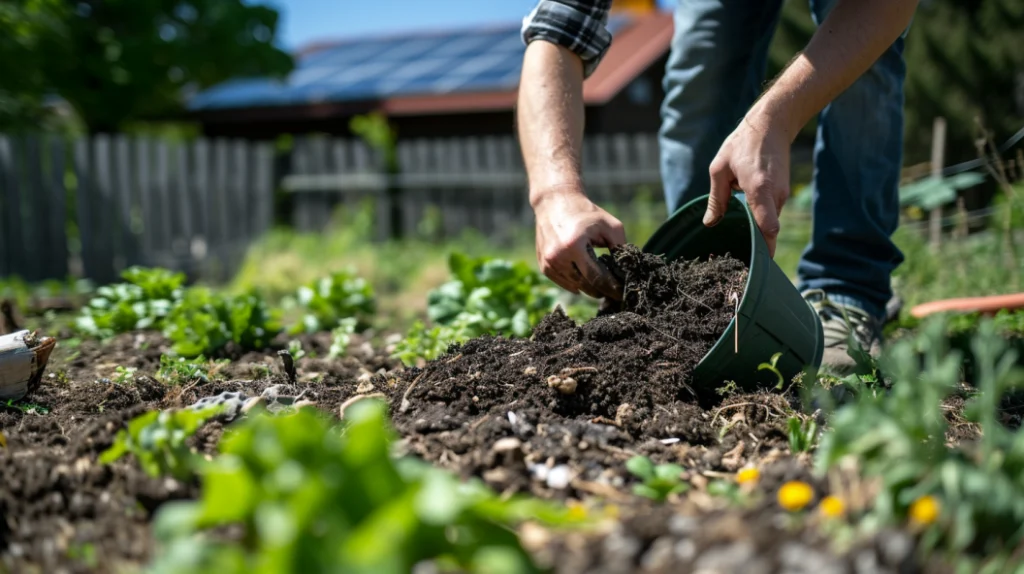
Composting Outside in a Yard
If you have a yard, composting outside can be a great option for you. Not only does it reduce waste and benefit the environment, but it also provides you with nutrient-rich compost to nourish your plants. There are two popular methods of composting in a yard: hot composting and cold composting.
Hot Composting at Home
Hot composting involves using a self-contained rotating bin or tumbler to speed up the decomposition process. This method requires more effort and attention but results in faster decomposition, typically within a few months. The key to hot composting is maintaining the right balance of green and brown materials, moisture, and oxygen.
Green materials, like grass clippings and vegetable scraps, provide nitrogen, while brown materials, such as dried leaves and twigs, provide carbon. The ideal ratio for hot composting is roughly three parts brown to one part green. Turning the compost regularly helps aerate the pile and accelerate decomposition, while adding moisture ensures that the microorganisms are active.
Remember to cover the compost pile to retain heat and moisture, especially during colder seasons. This promotes decomposition and prevents the compost from drying out.
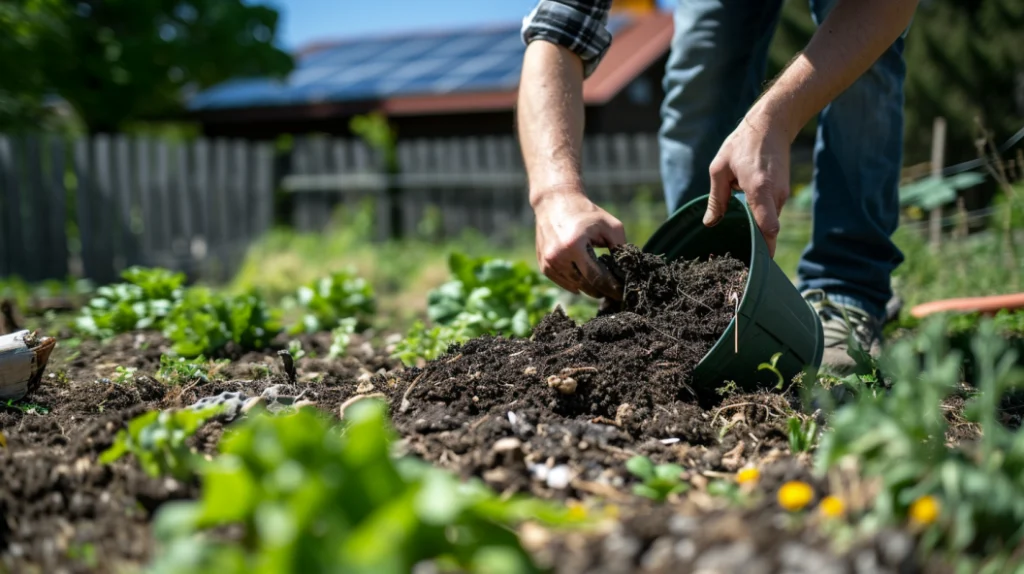
Cold Composting
If you prefer a low-maintenance method, cold composting is an excellent choice. With this method, you simply create an open-air pile in your yard and let nature take its course. Cold composting is generally slower than hot composting, taking around six months to a year to fully decompose.
To start cold composting, find a suitable location in your yard where you can create a compost pile. Place a layer of coarse material, like twigs or straw, at the bottom to allow for airflow. Then, gradually add your kitchen scraps, yard waste, and other compostable materials, layering them with brown materials like dried leaves or shredded paper.
Unlike hot composting, cold composting does not require regular turning or monitoring of moisture levels. However, it’s a good idea to occasionally check the pile for moisture. If it appears dry, add water to maintain a damp but not soggy consistency. Over time, the materials in the pile will break down naturally, thanks to the work of fungi, bacteria, and other decomposers.
Hot composting is faster, while cold composting is low-maintenance.
Both hot composting and cold composting contribute to reducing waste and creating nutrient-rich compost for your garden. The method you choose depends on your preferences and the amount of effort you want to put into the composting process. Below is a comparison table highlighting the main differences between hot and cold composting:
| Hot Composting | Cold Composting |
|---|---|
| Requires a self-contained rotating bin or tumbler | Does not require a bin or container |
| Composts materials faster (within a few months) | Takes longer to compost materials (around six months to a year) |
| Requires regular turning and monitoring of moisture levels | Low-maintenance, no turning required |
| Provides faster results but requires more effort | Slower process but requires less maintenance |
Regardless of the method you choose, backyard composting allows you to transform your organic waste into rich, dark compost that will improve the health of your soil and benefit your plants. Start composting today and make a positive impact on both your garden and the environment!
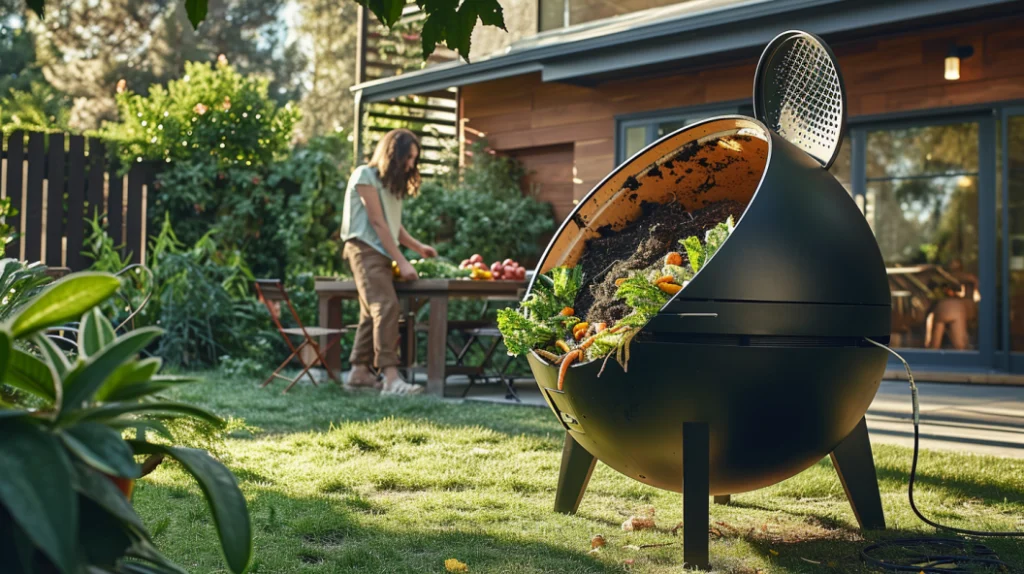
Micro-Composting Inside
If you have limited space, you can still engage in indoor composting and contribute to a more sustainable lifestyle. Indoor composting allows you to efficiently recycle organic waste right in the comfort of your home. There are various indoor composting bins available that provide convenient options for different composting methods. Two popular methods for micro-composting inside are aerobic composting and vermicomposting.
Aerobic Composting
Aerobic composting, also known as hot composting, mimics the natural decomposition process by creating optimal conditions for the composting microorganisms. This method requires the right balance of organic materials, including a mix of carbon-rich (brown) and nitrogen-rich (green) materials, along with moisture and oxygen for the microorganisms to thrive and break down the organic matter efficiently. Aerobic composting typically generates higher temperatures, which accelerates the decomposition process and helps kill off potential pathogens and weed seeds. It’s important to regularly turn the compost pile to maintain aeration and ensure even decomposition.
Vermicomposting
Vermicomposting is the process of composting with the help of earthworms. These incredible creatures have the ability to consume and digest organic waste, turning it into nutrient-rich castings. Vermicomposting is a viable indoor composting option as it produces minimal odor and operates at lower temperatures compared to traditional aerobic composting. By providing a suitable environment for the earthworms, such as a vermicomposting bin or worm farm, you can harness their natural composting abilities. The worms consume the organic matter you feed them, breaking it down and transforming it into nutrient-dense castings, often referred to as “black gold.”
Which method you choose depends on your personal preference, available space, and the amount of organic waste you generate. Both aerobic composting and vermicomposting offer effective ways to recycle kitchen scraps and create nutrient-rich compost for your plants.
When practicing indoor composting, it’s essential to manage any potential odors that may arise from the decomposition process. One solution is to use Febreze products specifically designed to eliminate odors caused by organic waste. Febreze can help maintain a fresh environment in your home while you compost responsibly.
Choosing Your Compost Bin
When it comes to successful composting, selecting the right compost bin is crucial. With a wide range of options available, you can choose between store-bought bins or opt for DIY solutions using everyday materials. Here are some compost bin options to consider:
- Store-Bought Bins: These ready-to-use compost bins are designed for convenience and efficiency. They come in various sizes and styles, such as tumblers, bins with removable doors, or stackable units. Some store-bought bins even come with filters to manage odors. Make sure to select a bin that suits your specific composting needs.
- DIY Compost Bins: If you enjoy upcycling and want to save money, building your own compost bin is a great option. You can repurpose plastic tubs, wooden pallets, or recycled barrels to create a customized composting system. DIY compost bins allow for flexibility in size, shape, and design, empowering you to tailor the bin to your unique space and requirements.
When choosing or building your compost bin, it’s essential to keep fire risk in mind. Composting materials can generate heat during the decomposition process, which may pose a fire hazard if not managed properly. To reduce the risk of fire, follow these guidelines:
- Choose a location for your compost bin away from flammable objects, such as buildings, fences, or dry vegetation.
- Avoid placing your compost bin on flammable surfaces, such as wooden decks or near propane tanks.
- Consider the size of your compost bin and ensure that it is appropriate for your available space.
Remember, proper maintenance and monitoring of your compost pile can minimize fire risks and promote safe composting.
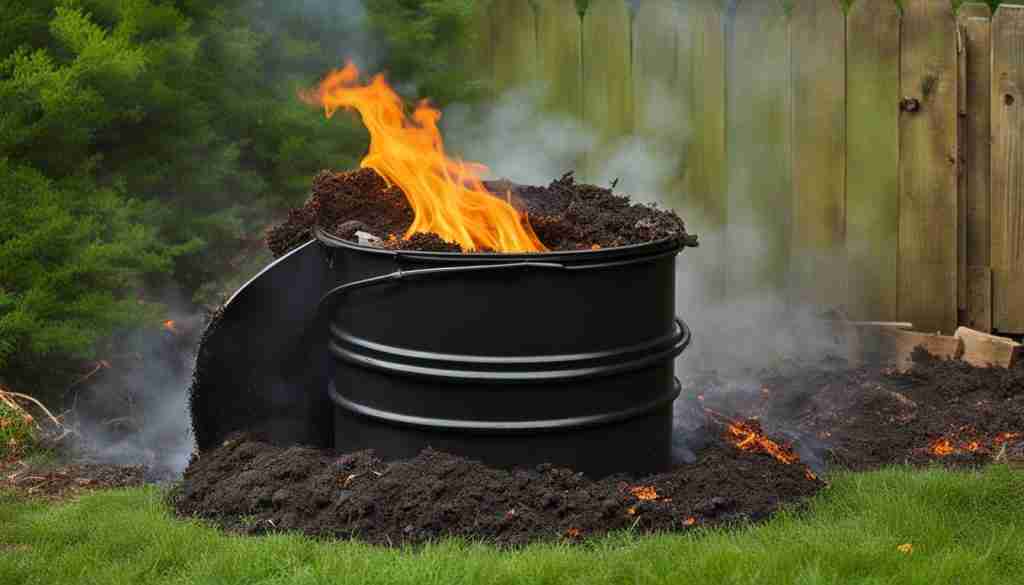
| Compost Bin Option | Pros | Cons |
|---|---|---|
| Store-Bought Bins |
|
|
| DIY Compost Bins |
|
|
Filling Your Compost Bin
The health of your compost bin depends on the materials you put in it. To create a thriving compost pile, you need to use a mix of green and brown materials. Green materials are nitrogen-rich, while brown materials are carbon-rich. The combination of these two types of materials will provide the necessary balance for successful composting.
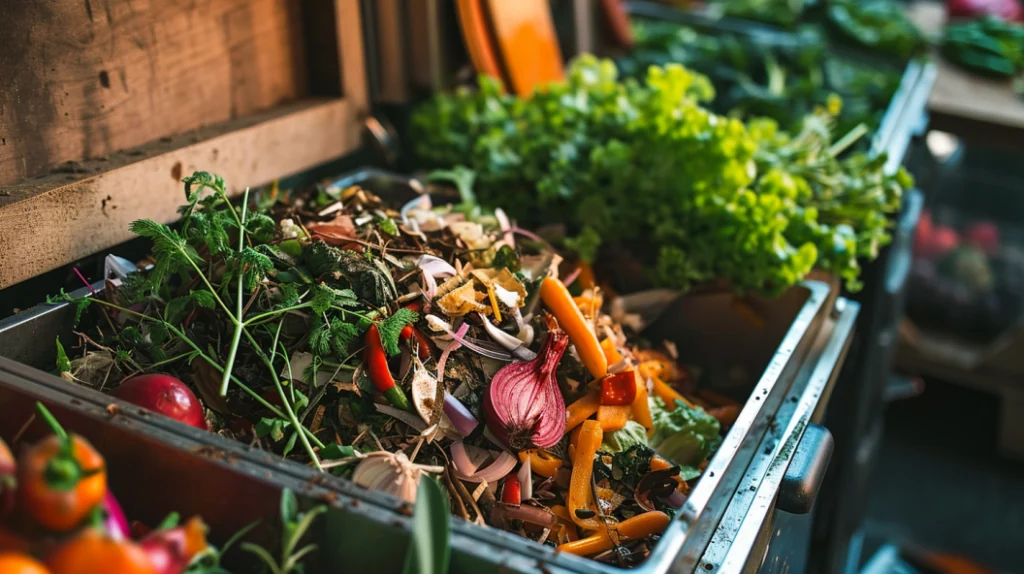
Green Materials:
- Grass clippings
- Fruit and vegetable peelings
- Coffee grounds
- Tea leaves
Brown Materials:
- Dead leaves
- Dead plants
- Weeds
- Hay
Layering these materials in your compost bin is essential. It’s best to start with a layer of woody brown matter at the bottom to ensure good airflow. Then, alternate between layers of green and brown materials as you fill the bin. This layering technique helps create a well-balanced compost pile.
Remember to keep the materials moist but not overly wet. Adding water periodically, especially during dry spells, will help maintain the right moisture level. This way, the microorganisms responsible for breaking down the organic matter can thrive and accelerate the composting process.
By properly filling your compost bin with a mix of green and brown materials, you’ll be on your way to producing nutrient-rich compost that will benefit your garden and the environment.
Compost Dos and Don’ts
When it comes to composting, knowing what to include in your compost bin and what to avoid is crucial for success. By following these guidelines, you can ensure that your compost pile remains healthy and efficient.
What to Compost
Here are some examples of compostable items that you can add to your compost bin:
- Eggshells
- Paper towel rolls
- Toilet paper rolls
- Paper bags
- Torn-up cotton clothing
- Fruit and vegetable scraps
- Coffee grounds
- Tea leaves
These items contribute essential nutrients and organic matter to your compost, helping it break down into nutrient-rich soil.
What Not to Compost
While there are many compostable items, certain materials should not be added to your compost bin. These items can attract pests, create odors, and disrupt the composting process. It’s best to leave these out:
- Cooked food items
- Meat
- Dairy products
- Bones
- Fats, grease, and oils
By avoiding these items, you can maintain a balanced compost bin and avoid any potential issues.
Remember, the key to successful composting is achieving the right balance of organic materials, moisture, and airflow. By composting the right items and avoiding the wrong ones, you can create nutrient-rich compost that will benefit your garden and help the environment.
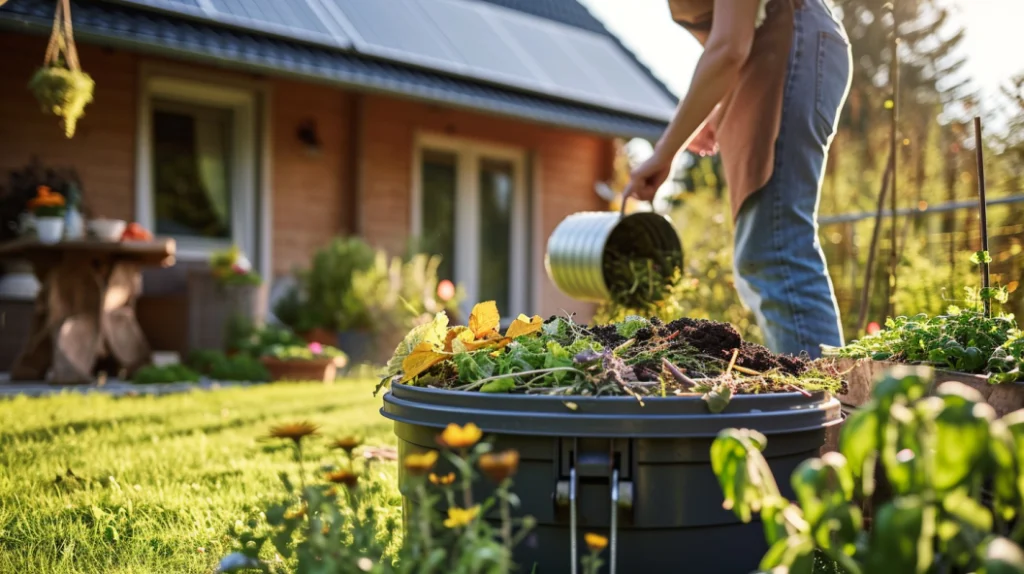
| Items you can compost | Items you should not compost |
|---|---|
| Eggshells | Cooked food items |
| Paper towel rolls | Meat |
| Toilet paper rolls | Dairy products |
| Paper bags | Bones |
| Torn-up cotton clothing | Fats, grease, and oils |
| Fruit and vegetable scraps | |
| Coffee grounds | |
| Tea leaves |
Understanding Compost
Compost is a nutrient-rich soil-like material that is created through the decomposition of organic matter. It includes fallen leaves, grass clippings, plant debris, vegetable scraps, and yard waste.
Compost offers a multitude of benefits for your garden and the environment. Let’s explore some of the key advantages:
- Soil Improvement: Compost improves the quality of the soil by enhancing its structure, texture, and fertility. It helps to break up heavy clay soil, allowing better drainage and increasing water retention in sandy soil. By adding compost to your soil, you can create the ideal conditions for plant growth.
- Nutrient-Rich Fertilizer: Compost is a natural source of essential nutrients for plants. It provides a balanced mix of nitrogen, phosphorus, potassium, and micronutrients that are vital for healthy plant development. By incorporating compost into your garden, you can ensure that your plants receive the nutrients they need to thrive.
- Environmental Benefits: Composting reduces the amount of organic waste sent to landfills, which helps to minimize greenhouse gas emissions. Additionally, composting helps prevent soil erosion and supports biodiversity by creating a healthy ecosystem in your garden.
By utilizing compost in your gardening practices, you can create a sustainable and thriving outdoor space. Let’s take a closer look at how compost can improve specific soil conditions:
- Fixing Sandy Soil: Sandy soil drains quickly and often lacks essential nutrients. Adding compost to sandy soil can increase its ability to retain water and nutrients, resulting in improved plant growth.
- Enhancing Clay Soil: Clay soil tends to become compacted, making it difficult for roots to penetrate and water to drain. When mixed with compost, clay soil becomes looser and more porous, improving its drainage and aeration.
Compost truly is a gardener’s best friend, providing a natural and sustainable solution for soil improvement and plant nourishment. It’s time to dig in and reap the benefits!
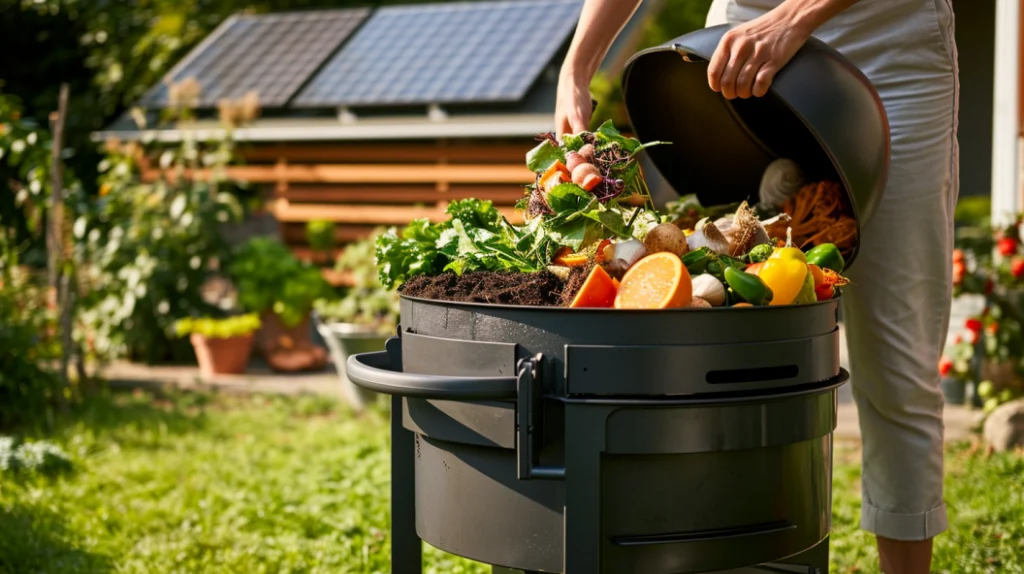
Where to Compost
Composting is a versatile practice that can be done in various locations, catering to different needs and space constraints. Whether you have access to a community garden or a small outdoor area like a patio or balcony, you can still participate in composting without requiring a large outdoor space.
If you’re part of a community garden, it’s an ideal place to compost your organic waste. Community gardens often have designated composting areas where you can contribute your kitchen scraps, yard waste, and other compostable materials. By composting collectively, you contribute to the health and sustainability of the garden, creating nutrient-rich soil that benefits everyone.
For those with limited outdoor space, you can still compost in small composting spaces such as patios or balconies. Utilize containers like compost bins, tumblers, or composting bags specifically designed for small-scale composting. These containers are compact and efficient, allowing you to compost kitchen scraps and other compostable materials without taking up much room.
If you prefer a more integrated approach, you can practice composting “in situ” by directly composting in your garden bed. This method involves placing organic waste directly into the soil, allowing it to break down naturally and enrich the existing garden ecosystem. Composting in situ is beneficial for nourishing your plants, improving soil health, and reducing waste.
Benefits of Composting in Community Gardens and Small Spaces:
- Reduces landfill waste and lowers your carbon footprint.
- Creates nutrient-rich soil for healthier, more vibrant plants.
- Improves water retention and drainage in the garden.
- Enhances soil structure and fertility over time.
- Promotes biodiversity by providing habitat for beneficial organisms.
- Encourages sustainable gardening practices within your community.
Remember, whether you choose to compost in a community garden or a small space, the key is finding the right spot and container that suits your needs. Composting doesn’t have to be limited by space constraints; it can be adapted to fit any living situation.
To inspire you further, here’s an image that showcases the beauty of composting in community gardens:
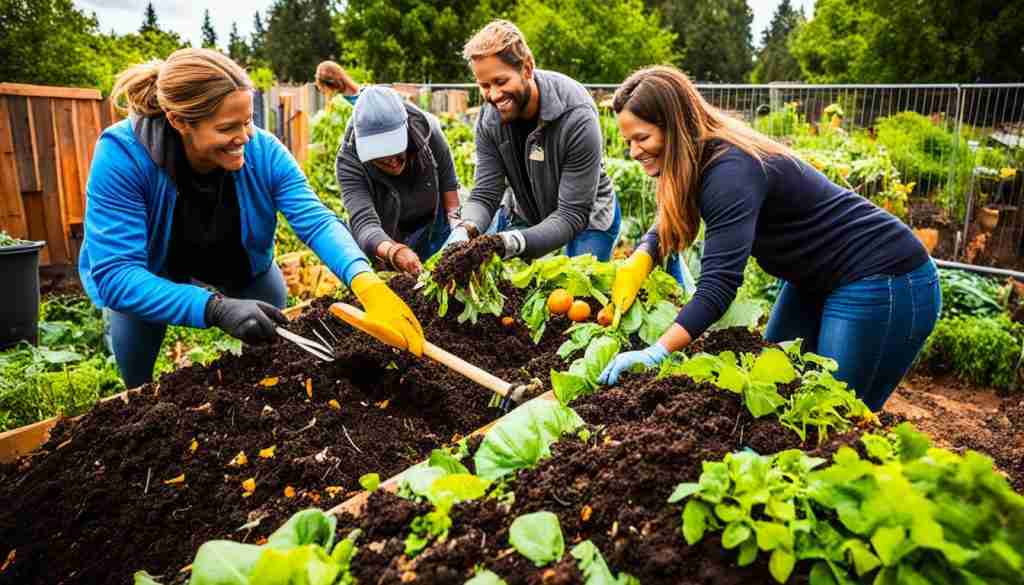
What Can and Can’t be Composted
Composting is an effective way to reduce waste and create nutrient-rich soil for your garden. While most organic materials can be composted, it’s important to know what to include and what to avoid. Here’s a breakdown of compostable and non-compostable materials:
Compostable Materials:
- Fallen leaves
- Grass clippings
- Shredded newspaper
- Vegetable scraps
- Coffee grounds
- Tea leaves
- Straw
These organic materials are rich in nutrients and break down easily, making them perfect for composting. By including them in your compost bin, you’ll create a valuable soil amendment that promotes healthy plant growth.
Non-Compostable Materials:
- Rocks
- Glass
- Metal
- Plastic
- Meat scraps
- Bones
- Seafood
- Dairy products
These materials are not suitable for composting as they do not break down easily and can attract pests. Inorganic materials like rocks, glass, and metal should be kept out of your compost bin to avoid contamination. Animal products like meat scraps, bones, seafood, and dairy products can create odors and attract pests if composted.
To ensure the health of your compost pile and prevent the spread of unwanted elements in your garden, it’s important to steer clear of weed seeds, roots, and diseased plants. These can survive the composting process and lead to unwanted growth or the spread of plant diseases.
Essential Ingredients for a Healthy Compost Pile
Composting is a natural process that requires the right mix of ingredients to create a healthy and nutrient-rich compost pile. To achieve optimal results, you need to ensure the presence of four essential components: brown matter, green matter, water, and air.
Brown matter refers to carbon-rich materials such as straw, dried leaves, or wood chips. These materials provide the necessary structure to the compost pile, allowing proper airflow and preventing it from becoming too wet or compacted. Brown matter also acts as a source of energy for the microorganisms involved in the decomposition process.
Green matter consists of nitrogen-rich materials like grass clippings, vegetable scraps, or coffee grounds. These materials provide the nutrients necessary for the microorganisms to break down the organic matter and speed up the composting process. Green matter also adds moisture to the pile, enhancing its overall decomposition efficiency.
Proper moisture content is crucial for a healthy compost pile, and that’s where water comes in. The compost pile should be damp, similar to a wrung-out sponge. It is important to add water when necessary to maintain the right moisture level. Avoid overwatering, as it can hinder the composting process and lead to unpleasant odors.
Air is a vital component for composting as it facilitates aerobic decomposition by providing oxygen to the microorganisms. Good airflow allows for the breakdown of organic matter into rich compost. Turning or aerating the compost pile regularly helps to introduce fresh air and prevent the development of anaerobic conditions.
To summarize, a successful compost pile requires a careful balance of brown matter, green matter, water, and air. By incorporating these essential ingredients, you can create a thriving environment for decomposition, resulting in nutrient-rich compost for your garden.
| Ingredient | Description |
|---|---|
| Brown Matter | Carbon-rich materials like straw, dried leaves, or wood chips. |
| Green Matter | Nitrogen-rich materials like grass clippings, vegetable scraps, or coffee grounds. |
| Water | Provides the necessary moisture for decomposition; maintain a damp pile without overwatering. |
| Air | Facilitates aerobic decomposition and prevents the development of anaerobic conditions; turn or aerate the pile regularly. |
Conclusion
Composting at home offers numerous benefits for both you and the environment. By engaging in home composting, you can reduce the amount of waste that goes into landfills, contributing to a more sustainable future. In addition, composting allows you to improve the quality of your soil and create nutrient-rich fertilizer for your garden.
Whether you choose to participate in a city-wide composting program, compost outside in your yard, or practice micro-composting indoors, there are methods and tools available that make it accessible to everyone. Following the steps outlined in this composting guide, you can become a composting legend and make a positive impact on the environment.
Remember, composting is an easy and effective solution, no matter your available space or time constraints. By composting at home, you not only benefit from the enriched soil and healthier plants but also contribute to a cleaner, greener planet. Start composting today and enjoy the multitude of benefits it brings to your garden and beyond.
FAQ
What is composting and why is it important?
Composting is the process of decomposing organic materials to create nutrient-rich soil. It is important because it reduces landfill waste, lowers carbon footprint, and improves soil quality.
How can I join a city-wide composting program?
You can check if your city offers a program for compost pick-up or drop-off. If not, reach out to community gardens or local farmers to see if they have composting programs in place.
What are the options for composting outside in a yard?
You can choose between hot composting, using a self-contained rotating bin, or cold composting, where you simply dump scraps into an open-air pile.
How can I compost inside my home?
There are various indoor composting bins available, including aerobic composting and vermicomposting. These systems can be placed in a pantry or under the sink.
How do I choose the right compost bin?
There are various options available, including store-bought bins or DIY options using plastic tubs, wooden pallets, or recycled barrels. Consider the size and location of the bin to prevent fire risks.
What materials should I put in my compost bin?
You’ll need a mix of green materials (fruit and vegetable peelings, coffee grounds) and brown materials (dead leaves, weeds) for a successful compost pile. Layering the materials and ensuring good airflow is important.
What can and can’t be composted?
Green materials like eggshells and paper towels can be composted, but avoid cooked food items, meat, dairy products, bones, or fats/grease/oils, as they can attract pests and disrupt the composting process.
What is compost and why is it beneficial?
Compost is a nutrient-rich soil-like material created through the decomposition of organic matter. It improves soil quality, helps with water retention, and provides essential nutrients for plants.
Where can I compost if I don’t have a yard?
You can compost in community gardens or small spaces like patios or balconies. Finding the right spot and container to suit your needs is key.
What can and can’t be composted?
Most organic materials can be composted, but avoid adding inorganic materials like rocks, glass, metal, or plastic. Animal products and diseased plants should also be avoided.
What are the essential ingredients for a healthy compost pile?
A healthy compost pile requires brown matter, green matter, water to keep it moist, and air for aerobic microorganisms to thrive.


